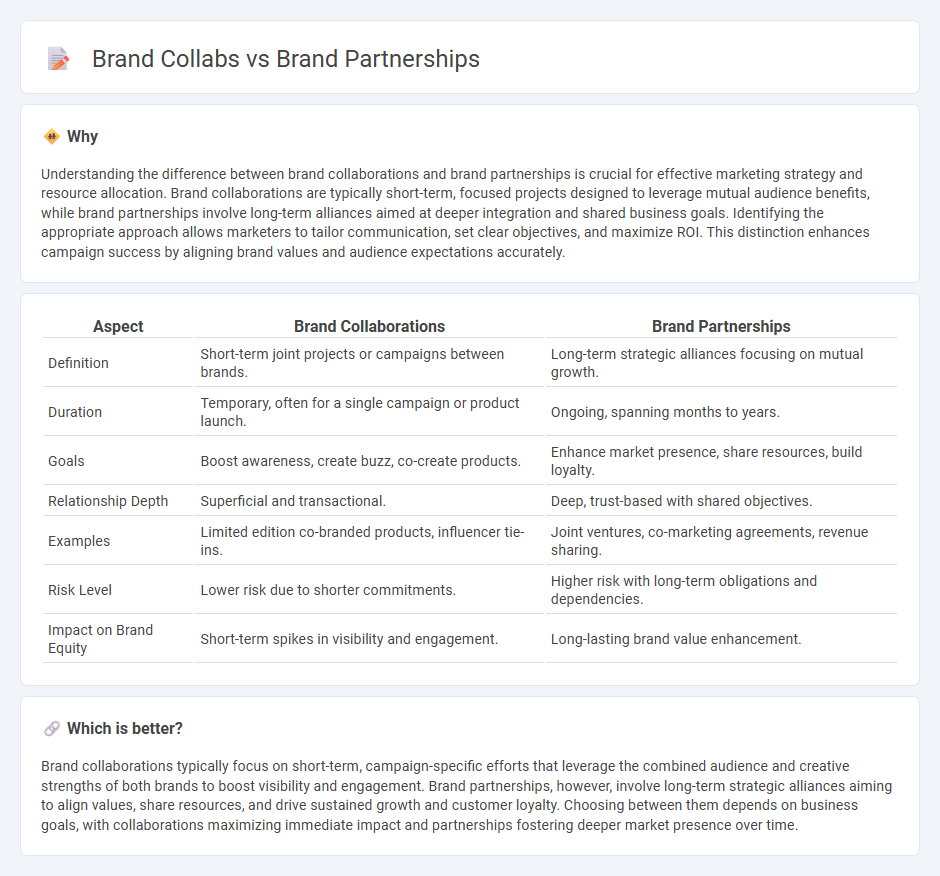
Brand collaborations involve two or more companies temporarily joining forces to create unique marketing campaigns or products, leveraging each other's audiences for mutual benefit. Brand partnerships represent a deeper, long-term alliance focused on shared goals, co-creation, and sustained value beyond short-term promotions. Explore how these strategies can elevate your marketing efforts and drive growth.
Why it is important
Understanding the difference between brand collaborations and brand partnerships is crucial for effective marketing strategy and resource allocation. Brand collaborations are typically short-term, focused projects designed to leverage mutual audience benefits, while brand partnerships involve long-term alliances aimed at deeper integration and shared business goals. Identifying the appropriate approach allows marketers to tailor communication, set clear objectives, and maximize ROI. This distinction enhances campaign success by aligning brand values and audience expectations accurately.
Comparison Table
| Aspect | Brand Collaborations | Brand Partnerships |
|---|---|---|
| Definition | Short-term joint projects or campaigns between brands. | Long-term strategic alliances focusing on mutual growth. |
| Duration | Temporary, often for a single campaign or product launch. | Ongoing, spanning months to years. |
| Goals | Boost awareness, create buzz, co-create products. | Enhance market presence, share resources, build loyalty. |
| Relationship Depth | Superficial and transactional. | Deep, trust-based with shared objectives. |
| Examples | Limited edition co-branded products, influencer tie-ins. | Joint ventures, co-marketing agreements, revenue sharing. |
| Risk Level | Lower risk due to shorter commitments. | Higher risk with long-term obligations and dependencies. |
| Impact on Brand Equity | Short-term spikes in visibility and engagement. | Long-lasting brand value enhancement. |
Which is better?
Brand collaborations typically focus on short-term, campaign-specific efforts that leverage the combined audience and creative strengths of both brands to boost visibility and engagement. Brand partnerships, however, involve long-term strategic alliances aiming to align values, share resources, and drive sustained growth and customer loyalty. Choosing between them depends on business goals, with collaborations maximizing immediate impact and partnerships fostering deeper market presence over time.
Connection
Brand collaborations and brand partnerships are interconnected strategies that leverage the strengths and audiences of multiple brands to create mutual value and expand market reach. These alliances enable co-branded campaigns or products that combine brand equity and foster increased consumer engagement through seamless integration of brand messages. By aligning goals and resources, both entities maximize exposure, drive sales, and strengthen their competitive positioning in the marketing landscape.
Key Terms
Co-Branding
Brand partnerships often involve long-term strategic alliances where two brands collaborate to create joint value, while brand collaborations tend to be shorter-term and more project-specific efforts. Co-branding exemplifies brand partnerships by merging two brand identities into a unified product or campaign, enhancing customer perception and leveraging combined brand equity for greater market impact. Explore how co-branding strategies can amplify brand awareness and drive consumer engagement through effective alliances.
Cross-Promotion
Brand partnerships and brand collaborations both leverage cross-promotion to amplify reach, yet brand partnerships tend to be long-term, strategic alliances while brand collaborations are often short-term projects with specific campaigns. Cross-promotion in brand partnerships involves consistent co-marketing efforts across multiple platforms to build mutual brand equity, whereas brand collabs usually highlight product integration or limited-edition releases to quickly generate buzz. Explore the unique advantages of brand partnerships and collaborations to optimize your cross-promotion strategy.
Strategic Alliance
Brand partnerships and brand collabs both involve collaboration between companies but differ in scope and strategic intent. Brand partnerships typically form long-term strategic alliances aimed at achieving mutual business goals, such as expanding market reach or enhancing brand equity, whereas brand collabs are often short-term, campaign-specific projects focused on co-creating products or content. Explore the key distinctions and benefits of strategic alliances in brand partnerships to unlock growth opportunities.
Source and External Links
What Is a Brand Partnership? (With Types and Advantages) - Indeed - A brand partnership is a collaboration between two or more companies to promote products or services through co-branding, including content partnerships, distribution partnerships, and sponsorship partnerships, each providing specific marketing advantages like increased exposure and customer incentives.
30 Brand Collaboration Examples that Went Viral - The CMO - Brand partnerships can boost awareness, create ambitious marketing campaigns, and increase sales as exemplified by collaborations like Adidas x Kanye West's Yeezy and Doritos x Taco Bell's Locos Tacos, which combined complementary brand strengths for mutual benefit.
20 Examples of Successful Co-Branding Partnerships (And Why ... - Co-branding partnerships, such as Target teaming with high-end fashion designers or Joybird collaborating with Sherwin-Williams, leverage each brand's audience and image to expand reach and create exclusive, appealing products.
 dowidth.com
dowidth.com